Home > News > How Does Bcl11a Regulate Hematopoietic Stem Cell Aging? Absin ELISA Kit Facilitates Inflammatory Mechanism Research.
How Does Bcl11a Regulate Hematopoietic Stem Cell Aging? Absin ELISA Kit Facilitates Inflammatory Mechanism Research.
- During the aging process, the functional decline of hematopoietic stem cells (HSCs) leads to a series of health issues such as anemia and immunodeficiency, and the underlying molecular mechanisms have long been a focus in the fields of immunology and aging research. Recently, a research team from institutions including Tongji University published a landmark study entitled "Bcl11a maintains hematopoietic stem cell function but accelerates inflammation-driven exhaustion during aging" in Science Immunology. This study reveals the dual role of the transcription factor Bcl11a in HSC aging, providing a novel target for delaying the aging of the hematopoietic system and improving related diseases. In this high-quality research, Absin's IL-1β ELISA Detection Kit (Catalog No.: abs520001) served as a key tool for analyzing inflammatory mechanisms, offering reliable support for the generation of research outcomes.


I. Research Background: Focusing on HSC Aging to Unravel the "Double-Edged Sword" Mystery of Bcl11a
Hematopoietic stem cells (HSCs) are the core for maintaining the homeostasis of the lifelong blood and immune systems; however, their functions gradually decline with age, characterized by reduced self-renewal capacity, accumulation of DNA damage, and imbalanced differentiation. Previous studies have found that the transcription factor Bcl11a is highly expressed in HSCs of young mice, which is crucial for maintaining their pluripotency, and it is abnormally overexpressed in various hematological malignancies. But what specific role does Bcl11a play in the aging process of HSCs? Is it a "protector" or an "accelerator"? This question remains unclear.
The research team put forward a core hypothesis: Bcl11a may exert dual effects on HSC aging through two modes—cell-autonomous (directly regulating the intrinsic functions of HSCs) and non-cell-autonomous (regulating the bone marrow microenvironment). To verify this hypothesis, the team designed a series of sophisticated experiments. As a key signaling molecule in the bone marrow microenvironment, the detection of the inflammatory factor IL-1β became a core link connecting the role of Bcl11a and HSC aging—and this is exactly the key scenario where Absin's abs520001 product exerts its function.
II. Research Approach: From "Cell-Autonomous" to "Microenvironment Regulation," Dissecting the Mechanism of Bcl11a Layer by Layer
1. Construction of an Inducible Mosaic Mouse Model to Precisely Track the Cell-Autonomous Role of Bcl11a
To avoid the limitations of traditional gene knockout/overexpression models, the research team innovatively constructed an inducible mosaic Bcl11a (iMOSBcl11a) mouse model. Mediated by Cre recombinase, this model enables the coexistence of Bcl11a-overexpressing cells (labeled with T1-eGFP) and control cells (labeled with T2-tdTomato) in the same mouse. These two types of cells share the same bone marrow microenvironment, allowing direct comparison of the intrinsic effects of Bcl11a on HSCs.
The results showed that HSCs overexpressing Bcl11a (T1-eGFP+) exhibited significantly enhanced self-renewal capacity during aging—manifested by higher hematopoietic reconstitution efficiency after transplantation, less DNA damage (reduced γH2AX foci), and the ability to maintain the polarized state of proteins such as H4K16ac (Figure 1). Further multi-omics analyses including RNA-seq and ATAC-seq confirmed that Bcl11a directly protects HSC function and delays their intrinsic aging by promoting the expression of genes related to HSC quiescence and inhibiting cell activation pathways.
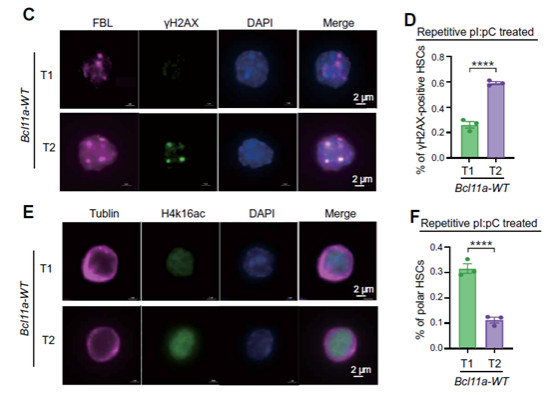
Figure 1: The number of γH2AX-labeled DNA damage foci is significantly reduced in HSCs overexpressing Bcl11a; the polarized state of H4K16ac is more stable in HSCs overexpressing Bcl11a. Scale bar = 2μm
2. Identifying the Key Target Fcer1g to Reveal the "Anti-Activation" Mechanism of Bcl11a
To clarify the molecular target of Bcl11a in regulating HSC quiescence, the research team combined CUT&Tag (chromatin binding site detection) with RNA-seq and ATAC-seq analyses. They found that Bcl11a can directly bind to the promoter region of the Fcer1g gene and inhibit its expression. Fcer1g is a common subunit of Fc receptors, and the signals mediated by it can activate HSC differentiation and impair self-renewal capacity (Figure 2).
Experiments confirmed that in HSCs overexpressing Bcl11a, the mRNA and protein levels of Fcer1g were significantly reduced, and these HSCs were insensitive to activation induced by IgG immune complexes (ICs). After knocking out Fcer1g, HSCs could still maintain self-renewal capacity even under inflammatory stimulation. This indicates that Bcl11a builds a "protective barrier" for HSCs by "inhibiting the Fcer1g-activation signaling axis."
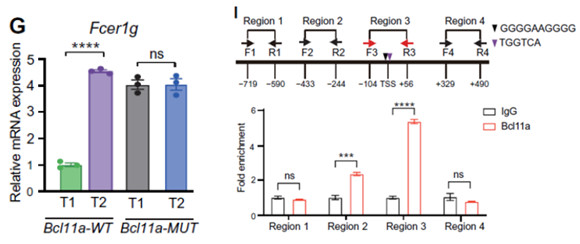
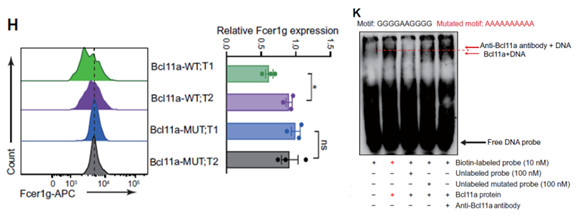
Figure 2: CUT&Tag verifies that Bcl11a binds to the Fcer1g promoter; Bcl11a overexpression significantly reduces the Fcer1g protein level in HSCs. FMO serves as the negative control.
3. Shifting to Non-Cell-Autonomous Effects: Bcl11a Accelerates Bone Marrow Inflammation and HSC Aging by Promoting IL-1βInterestingly, the research team found that Bcl11a is not merely a "protector"—its overexpression can disrupt the bone marrow microenvironment through a non-cell-autonomous manner:
* Step 1: Bcl11a promotes the secretion of IL-1β by bone marrow myeloid cells. Through CUT&Tag and dual-luciferase reporter assays, it was confirmed that Bcl11a can synergistically bind to the IL-1β gene promoter with the transcription factor PU.1, significantly enhancing its expression;
* Step 2: IL-1β impairs HSC function. Elevated IL-1β induces the expression of Fc receptors in HSCs, enhances Fcer1g signaling, and ultimately leads to excessive HSC differentiation and loss of self-renewal capacity (Figure 3);
* Key verification: Blocking IL-1β can reverse HSC aging. When mice were treated with the IL-1 receptor antagonist Anakinra, the functional decline of HSCs caused by Bcl11a overexpression was completely inhibited.
In this critical link, Absin's IL-1β ELISA Kit (abs520001) played a core role. The research team used this kit to accurately detect the IL-1β levels in bone marrow fluid and myeloid cell culture supernatants, directly confirming that the bone marrow IL-1β concentration in mice overexpressing Bcl11a was significantly higher than that in control mice, and the ability of myeloid cells to secrete IL-1β was significantly enhanced (right panel of Figure 3). This result provided direct quantitative evidence for the conclusion that "Bcl11a regulates the bone marrow microenvironment through IL-1β."
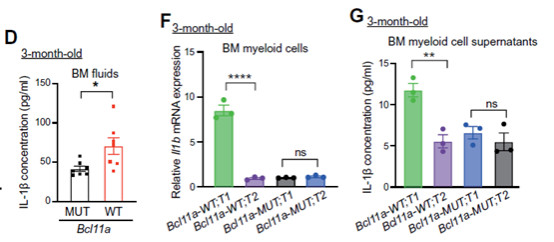
Figure 3: Bcl11a synergizes with PU.1 to activate the IL-1β promoter; Detection by Absin abs520001 shows that the IL-1β concentration in the bone marrow fluid of mice overexpressing Bcl11a is significantly increased (n=7, *P<0.01)
4. Summary: The "Dual Role" of Bcl11a and the Core Role of the IL-1β-Fcer1g AxisIntegrating all experimental results, the research team proposed a "dual-mechanism model" for Bcl11a regulating HSC aging (Figure 4):
* Cell-autonomous protection: Bcl11a directly inhibits Fcer1g expression, maintains HSC quiescence, and delays intrinsic functional decline;
* Non-cell-autonomous impairment: Bcl11a promotes the secretion of IL-1β by bone marrow myeloid cells, activates HSC differentiation through the IL-1β-Fcer1g axis, and accelerates their exhaustion.
This model perfectly explains the "double-edged sword" effect of Bcl11a in HSC aging and also provides a clear direction for intervention strategies—for example, by regulating the expression balance of Bcl11a or blocking IL-1β signaling, it is possible to simultaneously protect the intrinsic function of HSCs and improve the bone marrow microenvironment.
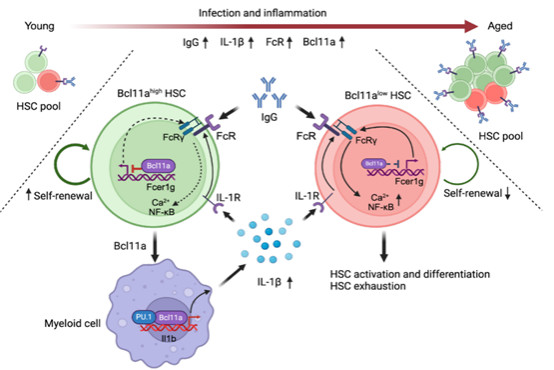
Figure 4: Red arrows: Non-cell-autonomous impairment effect of Bcl11a; Green arrows: Cell-autonomous protection effect of Bcl11a; Absin abs520001 is used to detect IL-1β levels and verify the microenvironment regulation mechanism.
III. Absin abs520001: Accurate Detection of IL-1β to Facilitate Inflammatory Mechanism Research
In this study, Absin's IL-1β ELISA Detection Kit (Catalog No.: abs520001) is not merely a "detection tool" but a key link connecting "Bcl11a regulation" and "microenvironmental inflammation." Why did this kit gain the trust of the research team? Its core advantages are reflected in the following three aspects:
* High sensitivity and specificity: It can accurately detect IL-1β levels in samples such as mouse bone marrow fluid and cell culture supernatants, with a minimum detection limit as low as the pg level, effectively distinguishing subtle differences between different experimental groups;
* Convenient operation and good repeatability: According to the kit instructions, batch sample detection can be completed in a short time, and the CV value of repeated experiments is < 10%, ensuring data reliability;
* Compatibility with multiple sample types: Stable detection results can be obtained with this kit for both freshly collected bone marrow fluid and in vitro cultured myeloid cell supernatants, meeting the needs of different scenarios in the research.
As shown in this study, abs520001 not only confirmed the promoting effect of Bcl11a overexpression on IL-1β secretion but also provided direct evidence for the core conclusion that "IL-1β is a key mediator of the non-cell-autonomous effect of Bcl11a," becoming an important driving force for research breakthroughs.
IV. Research Significance and Future Outlook
This study not only reveals the dual regulatory mechanism of Bcl11a in HSC aging but also provides a new target for the intervention of related diseases. For example, for hematopoietic function damage commonly seen after chemotherapy and CAR-T therapy, HSC recovery can be promoted by regulating Bcl11a expression or blocking IL-1β signaling. Meanwhile, this study also provides a new perspective for understanding the association between inflammation and aging.
As a reliable partner in life science research, Absin will continue to provide high-quality reagents and tools for researchers—from ELISA kits and antibodies to small-molecule compounds. Absin is committed to supporting more groundbreaking studies like this and promoting the progress of the life science field. In the future, it is expected that Absin products will play a role in more research fields such as immunology, gerontology, and oncology, providing solid support for the transformation of scientific research achievements.
Products Used
| Product Name | Catalog Number | Application Scenario |
| Mouse IL-1β ELISA Kit | abs520001 | Detection of IL-1β levels in serum, bone marrow fluid, and cell supernatants |
More ELISA Kits
| Catalog Number | Name |
| abs510001 | Human IL-2 ELISA Kit |
| abs510002 | Human IL-1 beta ELISA Kit |
| abs510003 | Human IL-6 ELISA Kit |
| abs520002 | Mouse IL-2 ELISA Kit |
| abs520003 | Mouse IL-4 ELISA Kit |
| abs530005 | Rat IL-2 ELISA Kit |
| abs530006 | Rat IL-4 ELISA Kit |
| abs530007 | Rat TNF-α ELISA Kit |
| abs540001 | Porcine IFN-gamma ELISA Kit |
| abs540002 | Porcine IL-1 beta ELISA Kit |
| abs540003 | Porcine IL-6 ELISA Kit |
Related News
- Titan Enterprises Develops Bespoke Calibration Rigs to Pioneer Ultrasonic Ultra- 10/17/2025
- How Does Bcl11a Regulate Hematopoietic Stem Cell Aging? Absin ELISA Kit Facilita 10/17/2025
- Merck to Acquire the Chromatography Business of JSR Life Sciences 10/17/2025
- Cold Chain Technologies Enables Sea Freight Success for Teva and Kuehne+Nagel 10/15/2025
- Accurate Comparison and Transferability of HPLC Methods and Results 10/15/2025
- Aiding the Exploration of the "Second Code" of Life Information: Epigenetics Sol 10/13/2025
- 10/13/2025
- Ferroptosis Signaling Pathway: Panoramic Analysis of Core Mechanisms and Researc 10/11/2025
- Everest Medicines Announces Publication of Etrasimod's Asian Multicenter Phase I 10/10/2025
- NeuroVigil’s iBrain™ in TIME’s “Best Inventions of 2025” 10/10/2025


